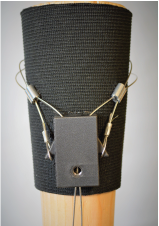Exoskeleton Cuff

Abstract: Assistive devices offer the opportunity to augment human motor behavior and increase functionality of individuals with motor impairments. However, anchoring such devices, be they passive compression sleeves or powered robotic exoskeletons, to the human body remains a perennial problem. An improperly fitting cuff results in slippage, which not only renders the device ineffective but can also cause discomfort and even harm to the user. At the same time, a tight-fitting cuff can also cause pain and injury with long-term wear. Here, we present a novel cuff design in which the compressive forces around the human limb are passively modulated as a function of shear load applied to the cuff. When subjected to cyclic loading, our design demonstrated negligible slippage on par with the performance of cuffs with high levels of constant compression. These preliminary results affirm the potential for our passive, variable-compression cuff to solve the problem of cuff slippage without unnecessarily exposing the user to sustained periods of high compression or limiting the level of assistance a device can provide.